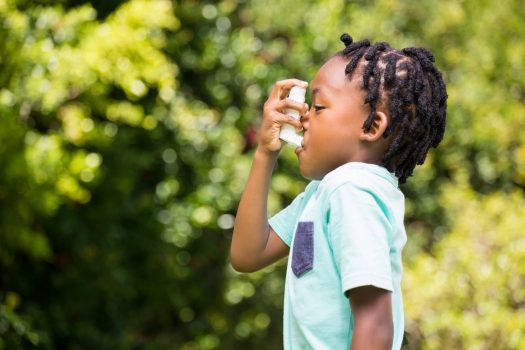Written by: Lakshmi Mahadevan, Ph.D., Associate Professor and Extension Specialist – Special Populations, Texas A&M AgriLife Extension Service.
Diagnosis: Asthma is a chronic lung disease that inflames and narrows the airways. Asthma causes recurring periods of wheezing (a whistling sound when breathing), chest tightness, shortness of breath, and coughing. The coughing often occurs at night or early in the morning (National Heart, Lung and Blood Institute [NHLBI], 2018)
A primary care doctor will diagnose asthma based on your child’s medical and family histories, a physical exam and test results. Asthma is determined to be intermittent, mild, moderate or severe. The level of severity will determine what treatment your child will start.
Most children who have asthma develop their symptoms before five years of age. Asthma is children younger than five years old can be harder to diagnose. A young child who has frequent wheezing with colds or respiratory infections is more likely to have asthma if (NHLBI, 2018):
- One or both parents have asthma
- The child has signs of allergies, including the allergic skin condition eczema
- The child has allergic reactions to pollens or other airborne allergens
- The child wheezes even when he or she doesn’t have a cold or other infection
Symptoms
Asthma symptoms vary from person to person (Mayo Clinic, 2018). Children may have infrequent asthma attacks, have symptoms only at certain times or have symptoms all the time.
Asthma signs and symptoms include:
- Shortness of breath
- Chest tightness or pain
- Trouble sleeping caused by shortness of breath, coughing or wheezing
- A whistling or wheezing sound when exhaling (wheezing is a common sign of asthma in children)
- Coughing or wheezing attacks that are worsened by a respiratory virus, such as a cold or the flu
Reacting to Diagnosis
The initial diagnosis of a child with asthma may generate an emotional crisis for parents. Dominant emotions include denial, grief, self-doubt, powerlessness, anxiety, and guilt (Stepney, Kane, & Bruzzese, 2011)
Denial: Initially parents may refuse to accept the diagnosis as a way to adapt. However, prolonged denial can negatively impact child’s treatment.
Grief: Parents may grieve the loss of the ideal child, their perceived normal future, independence, previously established normal routines and changing roles within the family. Grief is not finite for many parents’ coping with a child with asthma and may occur over the life-span.
Self-doubt and powerlessness: Parents may feel inadequate at managing asthma or doubt their ability to control environmental triggers or to juggle multiple medications, both of which can change with the seasonal nature of asthma.
Anxiety: Parents may also experience anxiety about how to care for their child, the uncertainty of the severity and timing of the next asthma episode, medication side-effects, and/or potential lack of communication by health care professionals.
Guilt: Another emotion parents may cope with in this phase is guilt. Parents may blame themselves for their child’s asthma and may feel as if they neglected their duty as parents when the child is diagnosed with asthma.
Coping with Diagnosis
Parents coping with diagnosis, may consider the following:
- Seek information on asthma management strategies
- Use strategies that are most effective. For instance, to increase the likelihood that the child takes daily medication, try keeping the medication with the child’s toothbrush (ie within plain sight and incorporate into routine).
- Practice identifying potential triggers and plan for availability of medication.
- Establish new routines that incorporate asthma management strategies.
- Establish and repeat family rituals such as dinnertime and bedtime so that stability and organization is restored.
Treatment
To control asthma, parents will need to partner with doctor to manage the child’s asthma. Children aged 10 or older—and younger children who are able—should take an active role in their asthma care. An active role to control child’s asthma includes:
- Arranging for treating other conditions that can interfere with asthma management.
- Avoiding things that worsen asthma (asthma triggers).
- Encouraging physical activity – although this can be a trigger, staying active is an important part of the child’s healthy lifestyle.
- Creating and following an asthma action plan for child both at home and school.
- An asthma action plan gives guidance to child on taking his or her medicines as prescribed; avoiding asthma triggers, incorporating t physical activity; tracking their level of asthma control; responding to worsening symptoms; and seeking emergency care when needed. For a detailed look at an Asthma Action Plan.
References
National Heart, Lung, and Blood Institute (NHLBI)
Stepney, C., Kane, K., & Bruzzese, J.-M. (2011). My Child is Diagnosed with Asthma, Now What? Motivating Parents to Help Their Children Control Asthma. The Journal of School Nursing: The Official Publication of the National Association of School Nurses, 27(5), 340–347.




![Blog Post Image: Pexels [Silhouette Photo of Jumping Children, photo by Margaret Weir, Sept. 22, 2017, CC0]](https://oneop.org/wp-content/uploads/2024/04/pexels-margaret-weir-620530-600x403.jpg)










